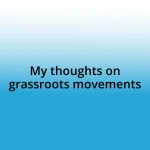Key takeaways:
- Effective collective decision-making relies on trust and communication, creating an environment where all voices feel valued.
- Managing conflict constructively can lead to innovation, as differing perspectives often spark creative solutions.
- Implementing structured approaches, like round-robin sharing, ensures equal participation and prevents dominance by strong personalities.
- Regular feedback and reflection sessions enhance team cohesion and improve future decision-making processes.

Understanding collective decision-making
Collective decision-making fascinates me because it taps into the diverse perspectives of a group. I remember a time when my team faced a critical project deadline. We gathered around a table, each sharing our ideas. The energy in that room was electric; it felt like a puzzle coming together as we navigated through different viewpoints, ultimately arriving at a solution none of us could have devised alone.
One of the most enlightening aspects of collective decision-making is the balance between collaboration and conflict. I’ve seen this dynamic play out firsthand during brainstorming sessions that turned tense as opinions clashed. Yet, those heated moments often led to breakthrough ideas. Have you ever noticed how the best solutions sometimes emerge from the most challenging discussions? I certainly have, and it always reminds me that discomfort can lead to creativity.
Moreover, I’ve learned that trust and communication are the backbone of effective collective decision-making. In a group I once worked with, we established ground rules that encouraged open dialogue. This simple practice transformed our interactions, as we felt safe to voice our opinions without fear of judgment. Isn’t it amazing how trust can enhance collective efforts and lead to more confident decisions? Through my experiences, I truly believe that understanding these elements can significantly improve how groups navigate their choices.

Importance of group dynamics
Group dynamics play a crucial role in how decisions unfold within a team. I’ve had the privilege of being part of several diverse groups, and I’ve noticed how the composition can influence outcomes dramatically. For instance, during a project at my last job, we had a mix of personalities—from the analytical thinkers to the more creative types. Each individual brought something unique to the table, which shaped our discussions in ways I hadn’t anticipated. It’s intriguing how varying perspectives can either harmonize or clash, ultimately fostering a richer decision-making environment.
The emotional aspect of group dynamics is equally important. I recall a particularly intense meeting where tensions ran high. As a passionate advocate for a certain approach, I felt my heart racing when others disagreed. However, that very environment pushed us to articulate our feelings and thoughts. By the end, we didn’t just settle on a decision; we established deeper relationships built on respect and understanding. This experience taught me that conflict, when managed well, can be a powerful catalyst for innovation.
To further illustrate the nuances of group dynamics, I believe it’s worth comparing various elements that affect how teams function. The following table captures some key aspects:
| Aspect | Impact on Decision-Making |
|---|---|
| Trust | Encourages open sharing of ideas, leading to more comprehensive solutions |
| Diversity | Offers a range of perspectives, enhancing creativity and problem-solving |
| Conflict | Can spark innovation but requires effective management to harness positively |
Each of these elements contributes uniquely to the collective decision-making process, underscoring the importance of group dynamics in navigating challenges.

Overcoming common challenges
Navigating through the challenges of collective decision-making can sometimes feel daunting, but I’ve learned that being proactive can make a world of difference. In one instance, our team faced a challenge where certain voices dominated the conversation, leaving quieter members feeling sidelined. I remember suggesting a “round-robin” format, allowing everyone to share their thoughts in turn. This small shift not only elevated contributions from all members but also transformed the group dynamic into one full of enthusiasm and inclusion.
Here are some common challenges and approaches to overcome them:
- Dominance of Strong Personalities: Implement structured turn-taking to ensure equal participation.
- Groupthink: Encourage dissenting opinions by framing them as valuable insights rather than opposition.
- Communication Barriers: Foster an atmosphere of openness where team members can express concerns without hesitation.
- Decision Fatigue: Break down complex decisions into smaller, manageable parts to avoid overwhelm and encourage clearer thinking.
From my experience, actively fostering a balanced environment enhances collaboration and leads to richer solutions. This type of intentional effort allows each member’s voice to resonate, making everyone feel valued and heard.

Techniques for effective collaboration
One technique I’ve found invaluable in promoting effective collaboration is the use of brainstorming sessions. I remember a project where we were stuck in a rut, unable to unlock the creative potential of the team. By organizing an open brainstorming session, I encouraged everyone to share their wildest ideas without the fear of judgment. This not only ignited a wave of creativity but also fostered a fun atmosphere where everyone’s input felt equally important. Have you ever experienced that electric feeling when ideas start flying around the room? It’s truly inspiring!
Another approach I’ve embraced is utilizing collaborative tools that facilitate communication. In my last role, we adopted a project management software that allowed us to have ongoing discussions, share documents, and keep track of progress in real time. It transformed our workflow, making it easier to stay aligned and informed. I was amazed by how clear expectations emerged just from everyone having access to the same information. Isn’t it fascinating how the right tools can simplify complex interactions?
Lastly, I can’t stress enough the power of regular feedback loops in collaboration. I recall a particular meeting where we implemented quick check-ins after major milestones. Each person shared their feelings about the process and outcomes. This practice not only helped us address issues early but also reinforced a culture of continuous improvement. It made me reflect: How often do we pause to genuinely assess our collective journey? By doing so, we created a space where we could all learn and grow together, strengthening our collaborative efforts.

Evaluating decision-making outcomes
Evaluating decision-making outcomes is a vital part of the collective process. Reflecting on a particularly challenging project, I remember how we gathered after implementing our decision to assess its effectiveness. Surprisingly, some outcomes didn’t align with our initial expectations; this experience taught me the crucial role of honest evaluation in shaping future decisions. Rather than feeling discouraged, I felt energized by the opportunity to learn and improve.
In another instance, we found ourselves reviewing the impact of our decision on team morale. It was illuminating to see how the choice affected not just results but also the emotional landscape of our group. I vividly remember some members expressing a newfound sense of responsibility and ownership, while others felt uncertain. This disparity prompted a deeper discussion about aligning our goals with the individual perspectives of team members, revealing how outcomes echo beyond the surface.
I’ve learned that effective evaluation requires fostering an environment where team members feel safe to share their experiences and feedback. A few times, I initiated anonymous surveys to gather genuine insights on decision outcomes. By doing this, I was able to uncover concerns that might not have surfaced otherwise, and I realized how essential it is to create spaces where voices can be heard without hesitation. Isn’t it fascinating how the simple act of asking for feedback can spark more profound conversations about our collective journey?

Lessons learned from my experience
Diving deep into my experiences with collective decision-making, I learned that listening to differing perspectives is not just beneficial—it’s essential. I remember a time when I wasn’t fully attuned to a quieter team member’s thoughts during a discussion. It turned out they had a valuable perspective that could have improved our final decision. This moment taught me that every voice matters, and sometimes the quietest ones can hold profound insights. Have you ever felt like your voice didn’t matter? I certainly have, and it’s a reminder for me to ensure everyone is encouraged to share.
Another lesson that stands out is the importance of flexibility in our approach. Early in my journey, I was fixated on a specific plan, convinced it was the best route. However, as we received feedback, I learned that adaptability was key to our success. I recall a pivotal team meeting where we pivoted from our initial strategy based on a fresh idea from a partnership within the team. It not only led to a better outcome but also fostered a spirit of collaboration that was energizing. Doesn’t it feel amazing when you realize that being open-minded can lead to unexpected paths?
Lastly, I realized that celebrating small wins can significantly enhance team cohesion. One project had a milestone that felt trivial, but I pushed for a team shoutout to recognize the accomplishment. The smiles on my colleagues’ faces were priceless, igniting a sense of camaraderie and motivation. I still wonder: how often do we overlook these moments of joy? Now, I make it a priority to acknowledge contributions and victories, no matter how small, because it cultivates a community where people feel valued and inspired to contribute fully.

Strategies for future improvements
Exploring strategies for future improvements, I believe establishing clearer communication channels is paramount. In one group project, we struggled with incomplete information because not everyone felt comfortable sharing updates. Afterward, I suggested using regular check-ins where everyone could provide short updates. It was transformative! Such a simple adjustment not only kept everyone in the loop but also fostered a trust that made people feel more connected.
Another strategy I’ve found effective is creating defined roles within the decision-making process. When I took part in a large initiative, I noticed how overwhelming it was for some team members to navigate the various tasks. By breaking down responsibilities and assigning specific roles, we saw a remarkable boost in engagement. It was as if a weight was lifted; people felt empowered to contribute their expertise. Have you ever witnessed that kind of shift in dynamics? It’s energizing!
Lastly, the practice of setting aside time specifically for reflection has become invaluable in my experience. After completing projects, I began to organize dedicated reflection sessions, detached from task discussions. I remember one particular afternoon where we gathered in a relaxed setting to share insights and feelings about the process. The resulting dialogue was a goldmine of ideas and emotions that paved the way for future endeavours. It made me realize: when we allow space for reflection, we unlock deeper layers of understanding that can profoundly influence our next steps.
















